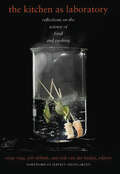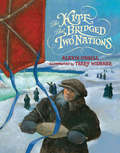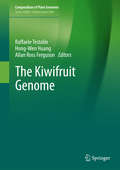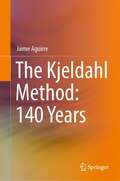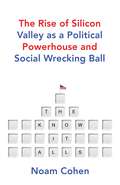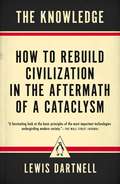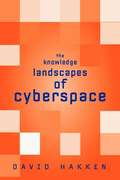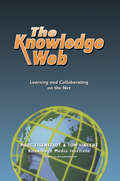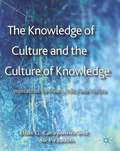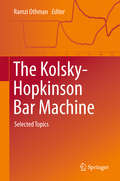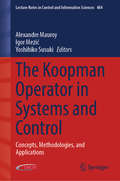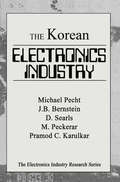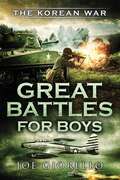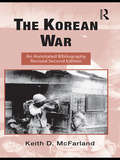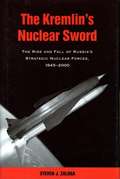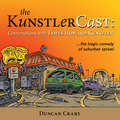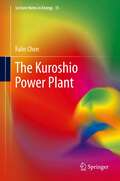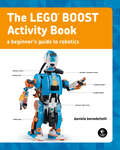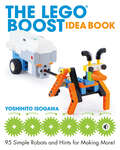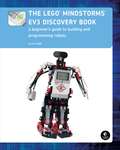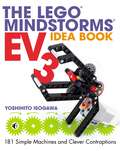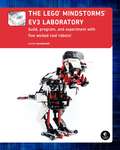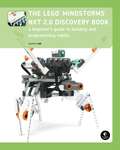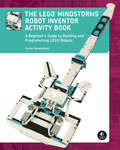- Table View
- List View
The Kitchen as Laboratory: Reflections on the Science of Food and Cooking (Arts and Traditions of the Table Perspectives on Culinary History)
by César Vega, Job Ubbink and Erik van der Linden&“Provides good perspective on the scientific approach to cooking while reflecting the interests and passions of each essay&’s author.&”—Peter Barham, author of The Science of CookingIn this global collaboration of essays, chefs and scientists advance culinary knowledge by testing hypotheses rooted in the physical and chemical properties of food. Using traditional and cutting-edge tools, ingredients, and techniques, these pioneers create, and sometimes revamp, dishes that respond to specific desires and serve up an original encounter with gastronomic practice. From the seemingly mundane to the food fantastic—from grilled cheese sandwiches, pizzas, and soft-boiled eggs to Turkish ice cream, sugar glasses, and jellified beads—the essays in The Kitchen as Laboratory cover a range of creations and their history and culture. This collection will delight experts and amateurs alike, especially as restaurants rely more on science-based cooking and recreational cooks increasingly explore the physics and chemistry behind their art. Contributors end each essay with their personal thoughts on food, cooking, and science, offering rare insight into a professional&’s passion for playing with food.&“Where else can one have fun pondering the acoustics of crunchy foods or the texture of an ice cream that stretches like a rubber band?&”—Robert Wolke, author of What Einstein Told His Cook: Kitchen Science Explained &“Not only an in-depth study of many areas of food science, but also an entertaining read. For someone like me, who relishes understanding more about cooking from the inside out, it&’s heartening to see this area of literature expanded.&”—Chef Wylie Dufresne, wd~50
The Kite that Bridged Two Nations: Homan Walsh and the First Niagara Suspension Bridge
by Alexis O'NeillHoman Walsh loves to fly his kite. And when a contest is announced to see whose kite string can span Niagara Falls, Homan is set on winning, despite the cold and the wind—and even when his kite is lost and broken. Homan's determination is beautifully captured in this soaring, poetic picture book that features Terry Widener's stunning acrylic paintings. Both author and illustrator worked with experts on both sides of the falls to accurately present Homan Walsh's story. The book also includes an extensive author's note, timeline, bibliography, and further resources.
The Kiwifruit Genome
by Raffaele Testolin Hong-Wen Huang Allan Ross FergusonThis book describes the basic botanical features of kiwifruit and its wild relatives, reports on the steps that led to its genome sequencing, and discusses the results obtained with the assembly and annotation. The core chapters provide essential insights into the main gene families that characterize this species as a crop, including the genes controlling sugar and starch metabolism, pigment biosynthesis and degradation, the ascorbic-acid pathway, fruit softening and postharvest metabolism, allergens, and resistance to pests and diseases. The book offers a valuable reference guide for taxonomists, geneticists and horticulturists. Further, since information gained from the genome sequence is extraordinarily useful in assessing the breeding value of individuals based on whole-genome scans, it will especially benefit plant breeders. Accordingly, chapters are included that focus on gene introgression from wild relatives and genome-based breeding.
The Kjeldahl Method: 140 Years
by Jaime AguirreThis book provides a comprehensive survey of the Kjeldahl method and its modifications. It covers all relevant topics, including sample digestion and its variables, distillation and determination of ammonia, equipment development, and concludes with a review of the literature published on the method. Since its introduction in 1883, the Kjeldahl method has been an essential analytical tool for nitrogen determination in research, academic and industrial laboratories. This makes the history of the Kjeldahl method of outstanding relevance to graduate students, postgraduate students, researchers, teachers, and laboratory staff in the fields of analytical chemistry, food/feed analysis, animal/human nutrition, soil/water analysis, and so forth."This method has probably been applied in one modification or another to every possible form of nitrogen, and in perhaps more laboratories than almost any other single type of analytical method" (Kirk, 1950).
The Know-It-Alls: The Rise of Silicon Valley as a Political Powerhouse and Social Wrecking Ball
by Noam CohenThe world&’s tech giants are at the centre of controversies over fake news, free speech and hate speech on platforms where influence is bought and sold. Yet, at the outset, almost everyone thought the internet would be a positive, democratic force, a space where knowledge could be freely shared to enable everyone to make better-informed decisions. How did it all go so wrong? Noam Cohen reports on the tech libertarians of Silicon Valley, from the self-proclaimed geniuses Jeff Bezos, Peter Thiel, Reid Hoffman and Mark Zuckerberg to the early pioneers at Stanford University, who have not only made the internet what it is today but reshaped society in the process. It is the story of how the greed, bias and prejudice of one neighbourhood is fracturing the Western world.
The Knowledge
by Lewis DartnellHow would you go about rebuilding a technological society from scratch? If our technological society collapsed tomorrow, perhaps from a viral pandemic or catastrophic asteroid impact, what would be the one book you would want to press into the hands of the postapocalyptic survivors? What crucial knowledge would they need to survive in the immediate aftermath and to rebuild civilization as quickly as possible--a guide for rebooting the world? Human knowledge is collective, distributed across the population. It has built on itself for centuries, becoming vast and increasingly specialized. Most of us are ignorant about the fundamental principles of the civilization that supports us, happily utilizing the latest--or even the most basic--technology without having the slightest idea of why it works or how it came to be. If you had to go back to absolute basics, like some sort of postcataclysmic Robinson Crusoe, would you know how to re-create an internal combustion engine, put together a microscope, get metals out of rock, accurately tell time, weave fibers into clothing, or even how to produce food for yourself? Regarded as one of the brightest young scientists of his generation, Lewis Dartnell proposes that the key to preserving civilization in an apocalyptic scenario is to provide a quickstart guide, adapted to cataclysmic circumstances. The Knowledge describes many of the modern technologies we employ, but first it explains the fundamentals upon which they are built. Every piece of technology rests on an enormous support network of other technologies, all interlinked and mutually dependent. You can't hope to build a radio, for example, without understanding how to acquire the raw materials it requires, as well as generate the electricity needed to run it. But Dartnell doesn't just provide specific information for starting over; he also reveals the greatest invention of them all--the phenomenal knowledge-generating machine that is the scientific method itself. This would allow survivors to learn technological advances not explicitly explored in The Knowledge as well as things we have yet to discover. The Knowledge is a brilliantly original guide to the fundamentals of science and how it built our modern world as well as a thought experiment about the very idea of scientific knowledge itself.
The Knowledge
by Lewis DartnellHow would you go about rebuilding a technological society from scratch?If our technological society collapsed tomorrow, perhaps from a viral pandemic or catastrophic asteroid impact, what would be the one book you would want to press into the hands of the postapocalyptic survivors? What crucial knowledge would they need to survive in the immediate aftermath and to rebuild civilization as quickly as possible--a guide for rebooting the world?Human knowledge is collective, distributed across the population. It has built on itself for centuries, becoming vast and increasingly specialized. Most of us are ignorant about the fundamental principles of the civilization that supports us, happily utilizing the latest--or even the most basic--technology without having the slightest idea of why it works or how it came to be. If you had to go back to absolute basics, like some sort of postcataclysmic Robinson Crusoe, would you know how to re-create an internal combustion engine, put together a microscope, get metals out of rock, accurately tell time, weave fibers into clothing, or even how to produce food for yourself?Regarded as one of the brightest young scientists of his generation, Lewis Dartnell proposes that the key to preserving civilization in an apocalyptic scenario is to provide a quickstart guide, adapted to cataclysmic circumstances. The Knowledge describes many of the modern technologies we employ, but first it explains the fundamentals upon which they are built. Every piece of technology rests on an enormous support network of other technologies, all interlinked and mutually dependent. You can't hope to build a radio, for example, without understanding how to acquire the raw materials it requires, as well as generate the electricity needed to run it. But Dartnell doesn't just provide specific information for starting over; he also reveals the greatest invention of them all--the phenomenal knowledge-generating machine that is the scientific method itself. This would allow survivors to learn technological advances not explicitly explored in The Knowledge as well as things we have yet to discover.The Knowledge is a brilliantly original guide to the fundamentals of science and how it built our modern world as well as a thought experiment about the very idea of scientific knowledge itself.
The Knowledge Landscapes of Cyberspace
by David HakkenHow is knowledge produced and used in cyberspace? David Hakken - a key figure in the anthropology of science and technology studies - approaches the study of cyberculture through the venue of knowledge production, drawing on critical theory from anthropology, philosophy and informatics (computer science) to examine how the character and social functions of knowledge change profoundly in computer-saturated environments. He looks at what informational technologies offer, how they are being employed, and how they are tied to various agendas and forms of power. Knowledge Landscapes will be essential for both social scientists and cultural studies scholars doing research on cyberculture.
The Knowledge Web: Learning and Collaborating on the Net (Open and Flexible Learning Series)
by Eisenstadt, Marc Vincent, TomFeaturing contributions from staff and associates of the Knowledge Media Institute at the UK Open University, this text provides a glimpse into the wide variety of projects undertaken in the development and assessment of distance learning technologies.
The Knowledge of Culture and the Culture of Knowledge
by Elias G. Carayannis Ali PirzadehThe Knowledge of Culture and the Culture of Knowledge explores the construct of information and information culture and its relationship to the prevailing culture. The author provides an analysis of the relationship of media to the core constructs in the book by explaining why they have been put together to form one single idea.
The Kolsky-Hopkinson Bar Machine: Selected Topics
by Ramzi OthmanIn this book, leading scientists share their vision on the Kolsky-Hopkinson bar technique, which is a well-established experimental technique widely used to characterize materials and structures under dynamic, impact and explosion loads. Indeed, the Kolsky-Hopkinson bar machine is not a simple experimental device. It is rather a philosophical approach to solve the problem of measuring impact events. The split Hopkinson pressure bar conventional device is mainly limited to test homogeneous ductile non-soft materials under uni-axial compression. Extending the use of this device to more versatile applications faces several challenges such as controlling the stress state within the specimen and mastering the measurement of forces and velocities at the specimen-bar interfaces and then the material properties. Thus, the topics discussed in this book mainly focused on the loading and processing parts.
The Koopman Operator in Systems and Control: Concepts, Methodologies, and Applications (Lecture Notes in Control and Information Sciences #484)
by Yoshihiko Susuki Alexandre Mauroy Igor MezićThis book provides a broad overview of state-of-the-art research at the intersection of the Koopman operator theory and control theory. It also reviews novel theoretical results obtained and efficient numerical methods developed within the framework of Koopman operator theory.The contributions discuss the latest findings and techniques in several areas of control theory, including model predictive control, optimal control, observer design, systems identification and structural analysis of controlled systems, addressing both theoretical and numerical aspects and presenting open research directions, as well as detailed numerical schemes and data-driven methods. Each contribution addresses a specific problem. After a brief introduction of the Koopman operator framework, including basic notions and definitions, the book explores numerical methods, such as the dynamic mode decomposition (DMD) algorithm and Arnoldi-based methods, which are used to represent the operator in a finite-dimensional basis and to compute its spectral properties from data. The main body of the book is divided into three parts:theoretical results and numerical techniques for observer design, synthesis analysis, stability analysis, parameter estimation, and identification;data-driven techniques based on DMD, which extract the spectral properties of the Koopman operator from data for the structural analysis of controlled systems; andKoopman operator techniques with specific applications in systems and control, which range from heat transfer analysis to robot control.A useful reference resource on the Koopman operator theory for control theorists and practitioners, the book is also of interest to graduate students, researchers, and engineers looking for an introduction to a novel and comprehensive approach to systems and control, from pure theory to data-driven methods.
The Korean Electronics Industry
by Michael PechtThe Korean Electronics Industry documents the technologies, manufacturing procedures, capabilities, and infrastructure that have made the Republic of Korea successful in the electronics industry. The book covers the major segments of Korea's electronics industry, including semiconductors, packaging, displays, printed circuit boards, and systems. In addition, this book examines the roles that government, associations, research organizations, educational institutions, and major companies have played in establishing an infrastructure where the industry can flourish.
The Korean War (Great Battles for Boys)
by Sibella Giorello Joe GiorelloEach book in the series focuses on the battles, leaders, tactics, and weapons that won (or lost) history’s most significant military clashes. Filled with historic photos and written in an engaging conversational style by a middle school history teacher, Great Battles for Boys brings history to life. These true tales of courage will excite even the most reluctant readers. <p><p> In this seventh book in the series, boys learn about The Korean War (1950-53) also known as the “The Forgotten War.” Despite more than 2 million casualties, most people—young and old—can not fully explain this international conflict or why the United States sacrificed so much treasure to fight it.
The Korean War: An Annotated Bibliography (Routledge Research Guides to American Military Studies)
by Keith D. McFarlandThe Korean War is the most comprehensive and detailed bibliography compiled to date on the American involvement in "The Forgotten War." In this revised and expanded second edition, Keith D. McFarland’s clearly written annotations provide concise descriptions of more than 2,600 of the most important books, articles, and documents written in English on the conflict in Korea. Key topics include origins of the war; the political and military roles of North and South Korea, the United States, the Soviet Union, China, Great Britain, Canada, Australia, South Africa, Turkey, and other United Nations members; campaigns and battles; weapons and uniforms; and the military and diplomatic aspects of the war. Specific subjects are easy to find using the index organized by topic and author, making The Korean War a necessity for every academic or research library.
The Kremlin's Nuclear Sword: The Rise and Fall of Russia's Strategic Nuclear Forces, 1945-2000
by Steven J. ZalogaA voluminous writer on arms trading and technology, Zaloga explores the development of the Soviet Union and Russian strategic nuclear forces, focusing primarily on the offensive forces though looking at strategic defensive forces when necessary. The intercontinental ballistic missile being the most important element of the forces, it sits at the center of the study. Annotation c. Book News, Inc. , Portland, OR (booknews. com)
The KunstlerCast: Conversations with James Howard Kunstler
by Duncan CraryBased off the popular podcast, this book collects one man’s conversations with an outspoken social critic on the negative effects of the suburbs.James Howard Kunstler has been described as “one of the most outrageous commentators on the American built environment.” An outspoken critic of suburban sprawl, Kunstler is often controversial and always provocative. The KunstlerCast is based on the popular weekly podcast of the same name, which features Kunstler in dialogue with author Duncan Crary, offering a personal window into Kunstler’s worldview.Presented as a long-form conversational interview, The KunstlerCast revisits and updates all the major ideas contained in Kunstler’s body of work, including:The need to rethink current sources of transportation and energyThe failure of urban planning, architecture and industrial societyAmerica’s plastic, dysfunctional cultureThe reality of peak oilWhether sitting in the studio, strolling city streets, visiting a suburban mall or even “Happy Motoring,” the grim predictions Kunstler makes about America’s prospects are leavened by his signature sharp wit and humor. This book is rounded out by commentary, footnotes and supplemental vignettes told from the perspective of an “embedded” reporter on the Kunstler beat.Readers may or may not agree with the more dystopian of Kunstler’s visions. Regardless, The KunstlerCast is bound to inspire a great deal of thought, laughter, and hopefully, action.Praise for The KunstlerCast“A bracing dose of reality for an unreal world.” —Stephen J. Dubner, co-author of Freakonomics and SuperFreakonomics“Erudite, eloquent . . . with good humor about the hilariously grotesque North American nightmare of car-addicted suburban sprawl.” —Dmitry Orlov, author of Reinventing Collapse“Prepare to be enlightened, infuriated and amused.” —Gregory Greene, Director, The End of Suburbia“So enlightening yet casual that the reader feels like they’re eavesdropping into the den of Kunstler’s prodigious mind.” —Andrew D. Blechman, author of Leisureville
The Kuroshio Power Plant
by Falin ChenBy outlining a new design or the Kuroshio power plant, new approaches to turbine design, anchorage system planning, deep sea marine engineering and power plant operations and maintenance are explored and suggested. The impact on the local environment, particularly in the face of natural disasters, is also considered to provide a well rounded introduction to plan and build a 30MW pilot power plant. Following a literature review, the six chapters of this book propose a conceptual design by focusing on the plant's core technologies and establish the separate analysis logics for turbine design and the relay platforms. This is tempered against the ecological impact of both the construction and operation of the plant. These proposed technologies and plans can be further applied to power generation in other waters such as the Gulf Stream, the East Australian Current the Humboldt Current and the East Africa Coastal Current. Engineers, students and industry professionals are provided with a solid introduction to power plant technology as well as a design with specific real world applications
The LEGO BOOST Activity Book
by Daniele BenedettelliAt last, fans of the LEGO BOOST robot building kit have the learning resource they've been missing! Enter The LEGO BOOST Activity Book: a full-color guide that will help readers learn how to build and code LEGO creations that move, explore their environment, grab and lift objects, and more.The LEGO BOOST kit lets younger builders create fun, multifunctional robots by combining bricks with code, but it doesn't come with a manual. With the help of this complete guide to the LEGO BOOST set, you'll be on your way to building and programming BOOST robots in no time.You'll begin your exploration by building a basic rover robot called MARIO to help you learn the fundamentals of the BOOST programming environment. Next, you'll add features to your rover to control its movement and make it repeat actions and react to colors and sounds. Once you've learned some programming basics, you'll learn how to program your robot to do things like follow lines on the ground, scan its environment to decide where to go, and even play darts. As final projects, you'll create two complete robots: BrickPecker to help you organize your bricks and CYBOT, a robot that talks, shoots objects, and executes voice commands. As you advance through the book, optional lessons aim to deepen your understanding of basic robotics concepts. Brain BOOSter sections let you dig into the math and engineering behind your builds while a host of experiments seek to test your skills and encourage you to do more with your robots. With countless illustrations, extensive explanations, and a wealth of coding examples to guide you, The LEGO BOOST Activity Book is sure to take you from beginning builder to robotics whiz and give your robot-building brain that needed boost!
The LEGO BOOST Idea Book: 95 Simple Robots and Hints for Making More!
by Yoshihito IsogawaThe LEGO® BOOST® Idea Book contains dozens of ideas for building simple robots with the LEGO BOOST set.The LEGO® BOOST® Idea Book explores 95 creative ways to build simple robots with the LEGO BOOST set. Each model includes a parts list, minimal text, screenshots of programs, and colorful photographs from multiple angles so you can re-create it without step-by-step instructions.You'll learn to build robots that can walk and crawl, shoot and grab objects, and even draw using a pen! Each model demonstrates handy mechanical principles that you can use to come up with your own creations.Models come with building hints and ideas for putting your own spin on things. Best of all, every part you need to build these models comes in the LEGO BOOST Creative Toolbox (set #17101).
The LEGO MINDSTORMS EV3 Discovery Book: A Beginner's Guide to Building and Programming Robots
by Laurens ValkLEGO MINDSTORMS has changed the way we think about robotics by making it possible for anyone to build real, working robots. The latest MINDSTORMS set, EV3, is more powerful than ever, and The LEGO MINDSTORMS EV3 Discovery Book is the complete, beginner-friendly guide you need to get started.Begin with the basics as you build and program a simple robot to experiment with motors, sensors, and EV3 programming. Then you’ll move on to a series of increasingly sophisticated robots that will show you how to work with advanced programming techniques like data wires, variables, and custom-made programming blocks. You’ll also learn essential building techniques like how to use beams, gears, and connector blocks effectively in your own designs.Master the possibilities of the EV3 set as you build and program:–The EXPLOR3R, a wheeled vehicle that uses sensors to navigate around a room and follow lines–The FORMULA EV3 RACE CAR, a streamlined remote-controlled race car–ANTY, a six-legged walking creature that adapts its behavior to its surroundings–SK3TCHBOT, a robot that lets you play games on the EV3 screen–The SNATCH3R, a robotic arm that can autonomously find, grab, lift, and move the infrared beacon–LAVA R3X, a humanoid robot that walks and talksMore than 150 building and programming challenges throughout encourage you to think creatively and apply what you’ve learned to invent your own robots. With The LEGO MINDSTORMS EV3 Discovery Book as your guide, you’ll be building your own out-of-this-world creations in no time!Requirements: One LEGO MINDSTORMS EV3 set (LEGO SET #31313)
The LEGO MINDSTORMS EV3 Idea Book: 181 Simple Machines and Clever Contraptions
by Yoshihito IsogawaThe LEGO® MINDSTORMS® EV3 Idea Book explores dozens of creative ways to build amazing mechanisms with the LEGO MINDSTORMS EV3 set. Each model includes a list of the required parts, minimal text, and colorful photographs from multiple angles so you can re-create it without the need for step-by-step instructions.You’ll learn to build cars with real suspension, steerable crawlers, ball-shooters, grasping robotic arms, and other creative marvels. Each model demonstrates simple mechanical principles that you can use as building blocks for your own creations.Best of all, every part you need to build these machines comes in one LEGO set (#31313)!
The LEGO MINDSTORMS EV3 Laboratory: Build, Program, and Experiment with Five Wicked Cool Robots
by Daniele Benedettelli<P>The LEGO® MINDSTORMS® EV3 set offers so many new and exciting features that it can be hard to know where to begin. Without the help of an expert, it could take months of experimentation to learn how to use the advanced mechanisms and numerous programming features. <P>In The LEGO MINDSTORMS EV3 Laboratory, author Daniele Benedettelli, robotics expert and member of the elite LEGO MINDSTORMS Expert Panel, shows you how to use gears, beams, motors, sensors, and programming blocks to create sophisticated robots that can avoid obstacles, walk on two legs, and even demonstrate autonomous behavior. You’ll also dig into related math, engineering, and robotics concepts that will help you create your own amazing robots. Programming experiments throughout will challenge you, while a series of comics and countless illustrations inform the discussion and keep things fun. <P>As you make your way through the book, you’ll build and program five wicked cool robots: <br>–ROV3R, a vehicle you can modify to do things like follow a line, avoid obstacles, and even clean a room <br>–WATCHGOOZ3, a bipedal robot that can be programmed to patrol a room using only the Brick Program App (no computer required!) <br>–SUP3R CAR, a rear-wheel-drive armored car with an ergonomic two-lever remote control <br>–SENTIN3L, a walking tripod that can record and execute color-coded sequences of commands <br>–T-R3X, a fearsome bipedal robot that will find and chase down prey <P>With The LEGO MINDSTORMS EV3 Laboratory as your guide, you’ll become an EV3 master in no time. <br>Requirements: One LEGO MINDSTORMS EV3 set (LEGO SET #31313)
The LEGO MINDSTORMS NXT 2.0 Discovery Book: A Beginner's Guide to Building and Programming Robots
by Laurens ValkDiscover the many features of the LEGO® MINDSTORMS® NXT 2.0 set. The LEGO MINDSTORMS NXT 2.0 Discovery Book is the complete, illustrated, beginner's guide to MINDSTORMS that you've been looking for.The crystal clear instructions in the Discovery Book will show you how to harness the capabilities of the NXT 2.0 set to build and program your own robots. Author and robotics instructor Laurens Valk walks you through the set, showing you how to use its various pieces, and how to use the NXT software to program robots. Interactive tutorials make it easy for you to reach an advanced level of programming as you learn to build robots that move, monitor sensors, and use advanced programming techniques like data wires and variables. You'll build eight increasingly sophisticated robots like the Strider (a six-legged walking creature), the CCC (a climbing vehicle), the Hybrid Brick Sorter (a robot that sorts by color and size), and the Snatcher (an autonomous robotic arm). Numerous building and programming challenges throughout encourage you to think creatively and to apply what you've learned as you develop the skills essential to creating your own robots.Requirements: One LEGO MINDSTORMS NXT 2.0 set (#8547)Features:–A complete introduction to LEGO MINDSTORMS NXT 2.0–Building and programming instructions for eight innovative robots–50 sample programs and 72 programming challenges (ranging from easy to hard) encourage you to explore newly learned programming techniques–15 building challenges expand on the robot designs and help you develop ideas for new robotsWho is this book for?This is a perfect introduction for those new to building and programming with the LEGO MINDSTORMS NXT 2.0 set. The book also includes intriguing robot designs and useful programming tips for more seasoned MINDSTORMS builders.
The LEGO MINDSTORMS Robot Inventor Activity Book: A Beginner's Guide to Building and Programming LEGO Robots
by Daniele BenedettelliAn introduction to the LEGO Mindstorms Robot Inventor Kit through seven engaging projects.With its amazing assortment of bricks, motors, and smart sensors, the LEGO® MINDSTORMS® Robot Inventor set opens the door to a physical-meets-digital world. The LEGO MINDSTORMS Robot Inventor Activity Book expands that world into an entire universe of incredibly fun, uniquely interactive robotic creations! Using the Robot Inventor set and a device that can run the companion app, you&’ll learn how to build bots beyond your imagination—from a magical monster that gobbles up paper and answers written questions, to a remote-controlled transformer car that you can drive, steer, and shape-shift into a walking humanoid robot at the press of a button.Author and MINDSTORMS master Daniele Benedettelli, a robotics expert, takes a project-based approach as he leads you through an increasingly sophisticated collection of his most captivating robot models, chapter by chapter. Each project features illustrated step-by-step building instructions, as well as detailed explanations on programming your robots through the MINDSTORMS App—no coding experience required.As you build and program an adorable pet turtle, an electric guitar that lets you shred out solos, a fully functional, whiz-bang pinball machine and more, you&’ll discover dozens of cool building and programming techniques to apply to your own LEGO creations, from working with gears and motors, to smoothing out sensor measurement errors, storing data in variables and lists, and beyond. By the end of this book, you&’ll have all the tools, talent and inspiration you need to invent your own LEGO MINDSTORMS robots.
